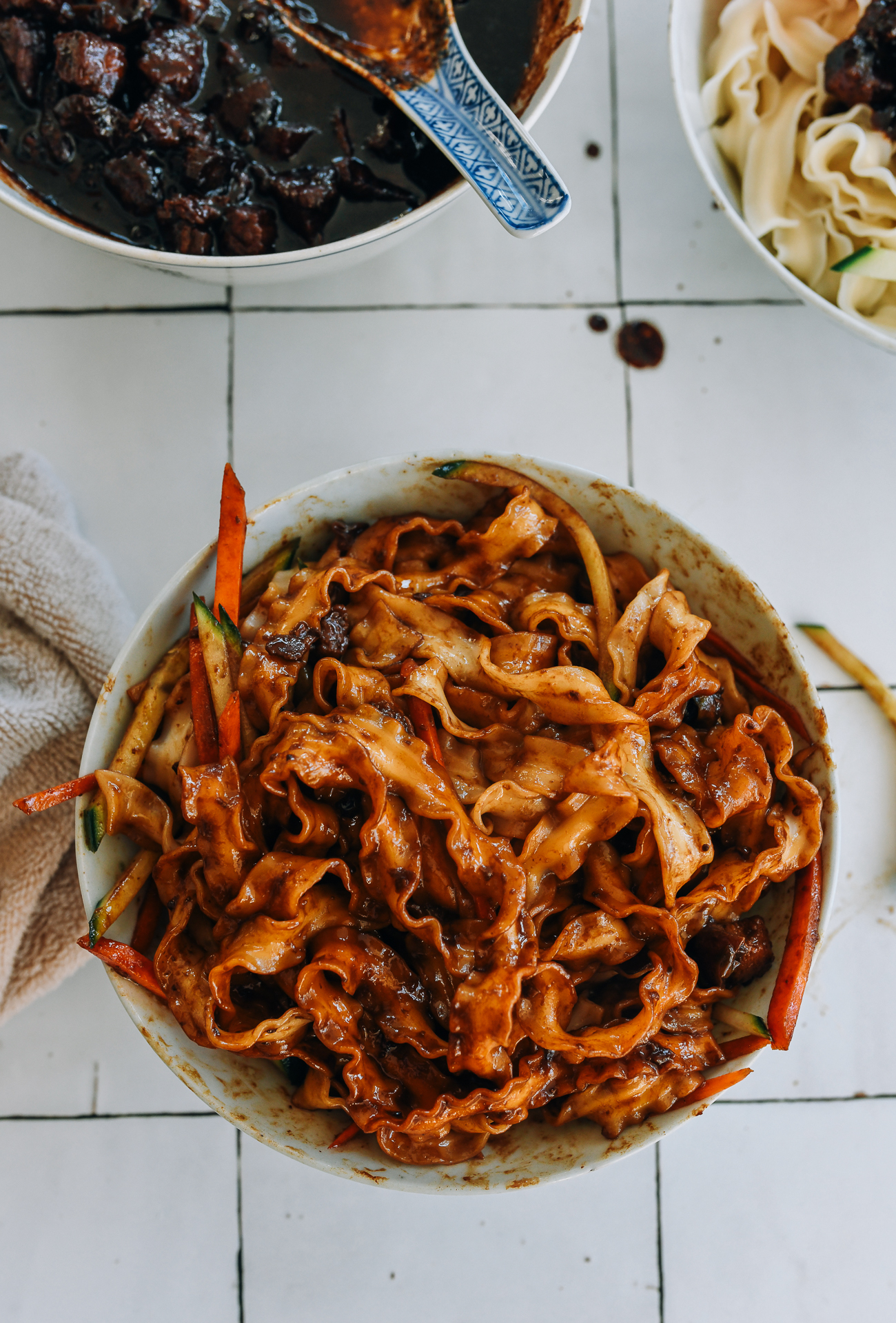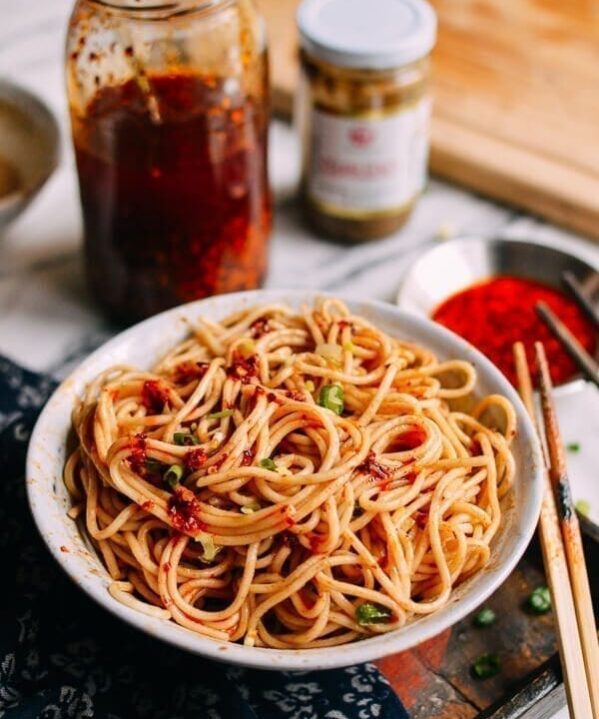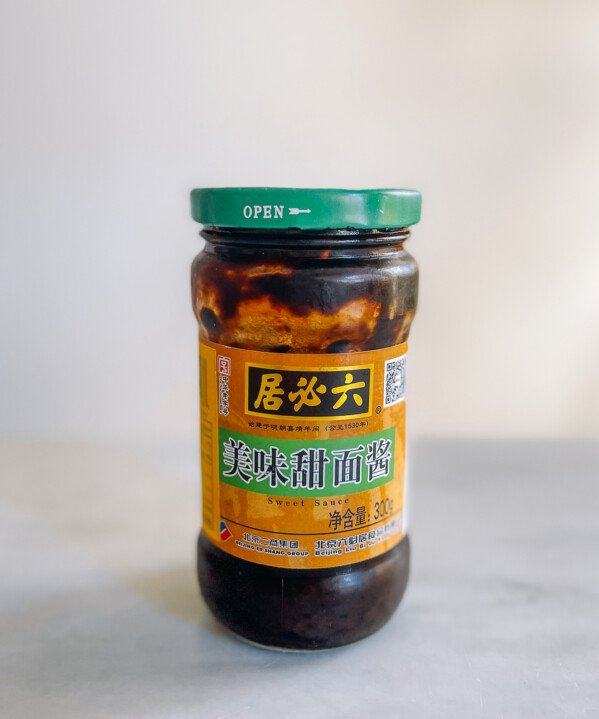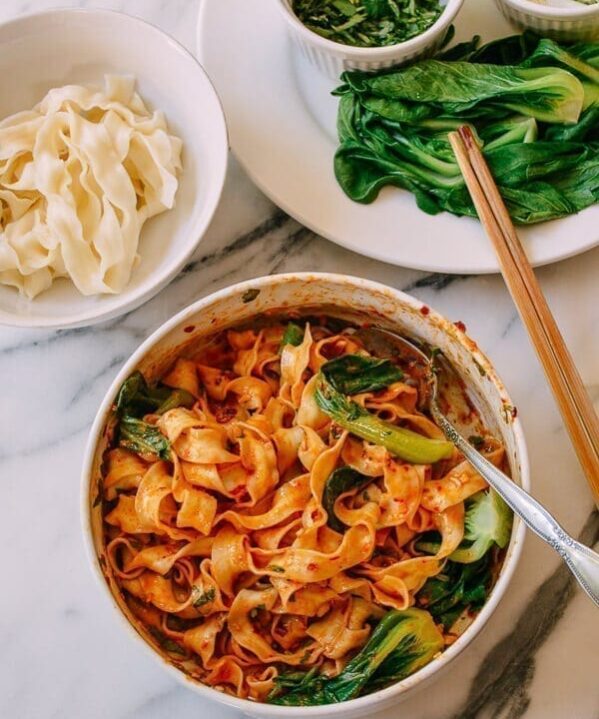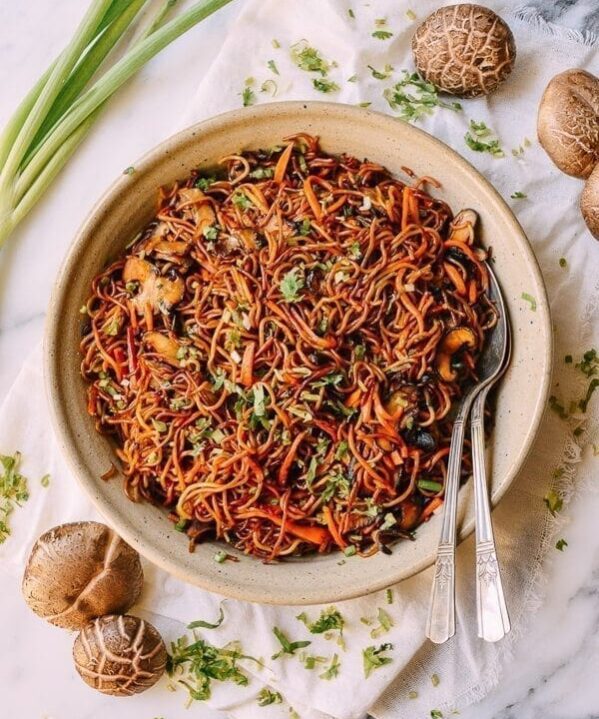Zha Jiang Mian, which translates to “Fried Sauce Noodles,” is a popular Beijing noodle dish unique to every family. It’s so famous in China that the mere mention of it immediately makes people think of Beijing.
Our recipe is new and improved, with flavorful chunks of pork belly and a silky sauce made to perfectly coat a bowl of fresh noodles!
Note:
This recipe was originally published on August 2, 2014. We have since re-tested and updated the recipe.
The original recipe was from a Beijing friend’s family—with some uncommon additions like mushrooms. Our new version is more in line with what a traditional Zha Jiang Mian tastes like. If you’re looking for our 2014 version, you can still find it at the end of this post!
Chinese Home Cooking
This Zha Jiang Mian represents Chinese home cooking at its finest. 老北京人 (lǎo běijīng rén), i.e., native Beijingers, and 北方人 (běifāng rén), or “Northerners” all have a slightly different take on this dish. Everyone thinks their family makes the best Zha Jiang Mian, and who’s to say that that’s not true?
Some like it saltier, some like it sweeter. Some will even top it with raw garlic for an extra kick.
(During our time in Beijing, we noticed that Northern Chinese folks really love their raw garlic! That’s why we’ve included some minced garlic as an optional topping.)
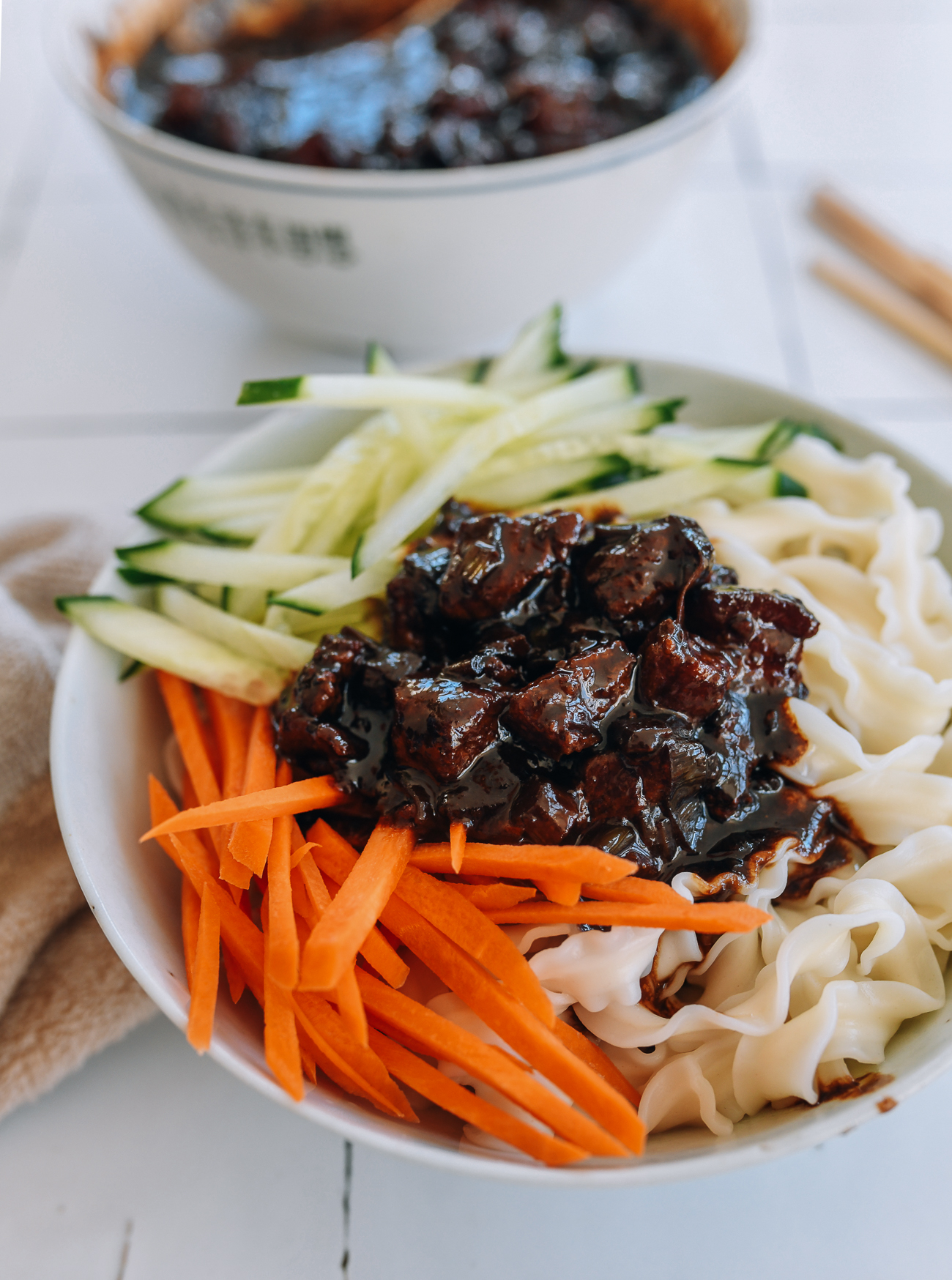
It also may be a disappearing art. A commenter on our old Zha Jiang Mian recipe noted that it had been quite some time since she had a truly delicious bowl of Zha Jiang Mian. Shoutout to Ivy Liu for providing some tasting notes that we found very useful!
An Aside: Korean Jajangmyeon
You may have seen a Korean version of this dish—Korean jajangmyeon—which is very different from the Chinese version.
In the Korean dish, there are larger vegetable chunks and a Korean black bean paste with a stronger flavor. It’s a true black bean noodle recipe, as you’ll find that Korean black bean paste is dark as midnight! The sauces used in this recipe rely on fermented soybeans and fermented wheat flour.
Three Kinds of “Bean” Paste
Beijing Zha Jiang Mian is traditionally made with three sauces:
- Dry yellow soybean paste (干黄酱)
- Fermented yellow soybean paste (黄豆酱) or ground bean sauce
- And finally, sweet bean paste (甜面酱), which isn’t made with beans at all, but is actually a fermented wheat flour paste. (Hence the reason “bean” is in quotes above. Don’t ask me why it was translated as “bean paste” in English!)
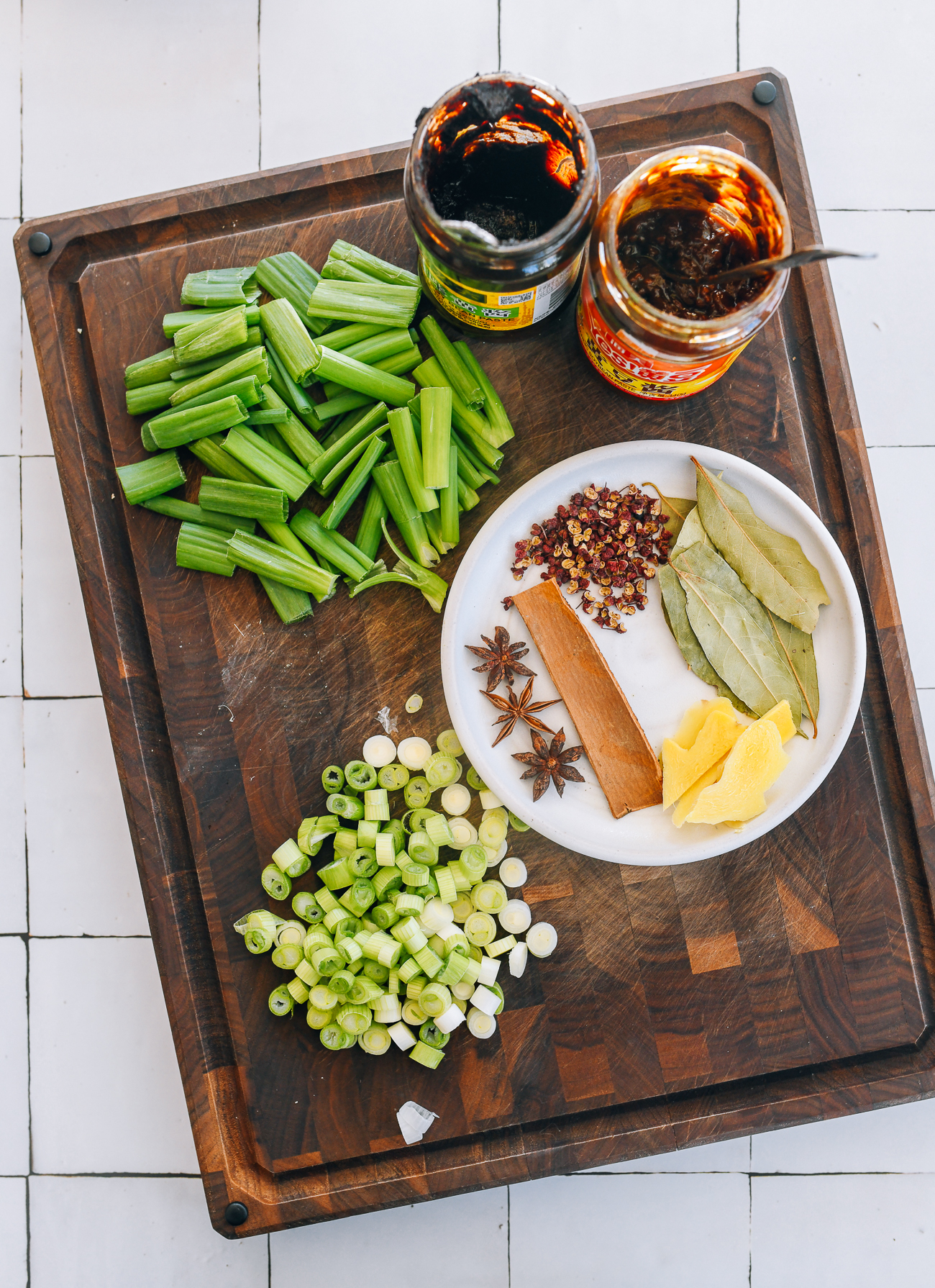
In this recipe, we use two of those essential pastes. The first is the fermented yellow soybean paste (黄豆酱), which is quite salty. You can also use a product labeled in English as ground bean sauce.
Tip!
If you are searching for these Chinese soybean pastes, search for “yellow soybean paste” as the Chinese word for “soybean” directly translates to “yellow bean” or 黄豆 (huáng2 dòu4).
The second is the sweet bean paste (tian mian jiang – 甜面酱), which isn’t made with beans at all and is quite sweet. It can be found in a can or in plastic tubs. Some recipes use hoisin sauce and sweet bean sauce interchangeably, but generally I find hoisin sauce brands (especially the more commercial ones) are thinner and lighter.
Better if you can find the darker, more concentrated tian mian jiang for this dish. Just look for these Chinese characters: 甜面酱. Ask the staff at your local Chinese grocery store to help you find it!
Read more about ground bean sauce and tian mian jiang in our Chinese Ingredients Glossary articles!
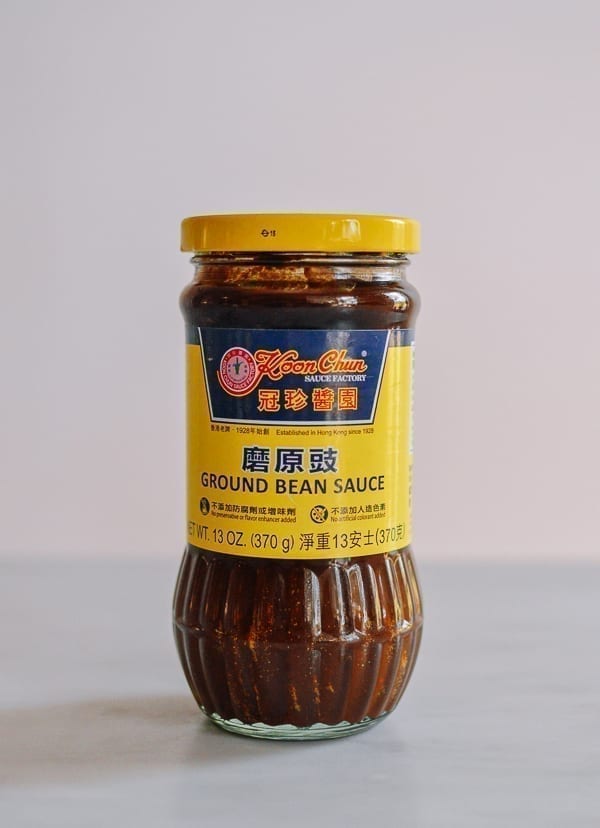
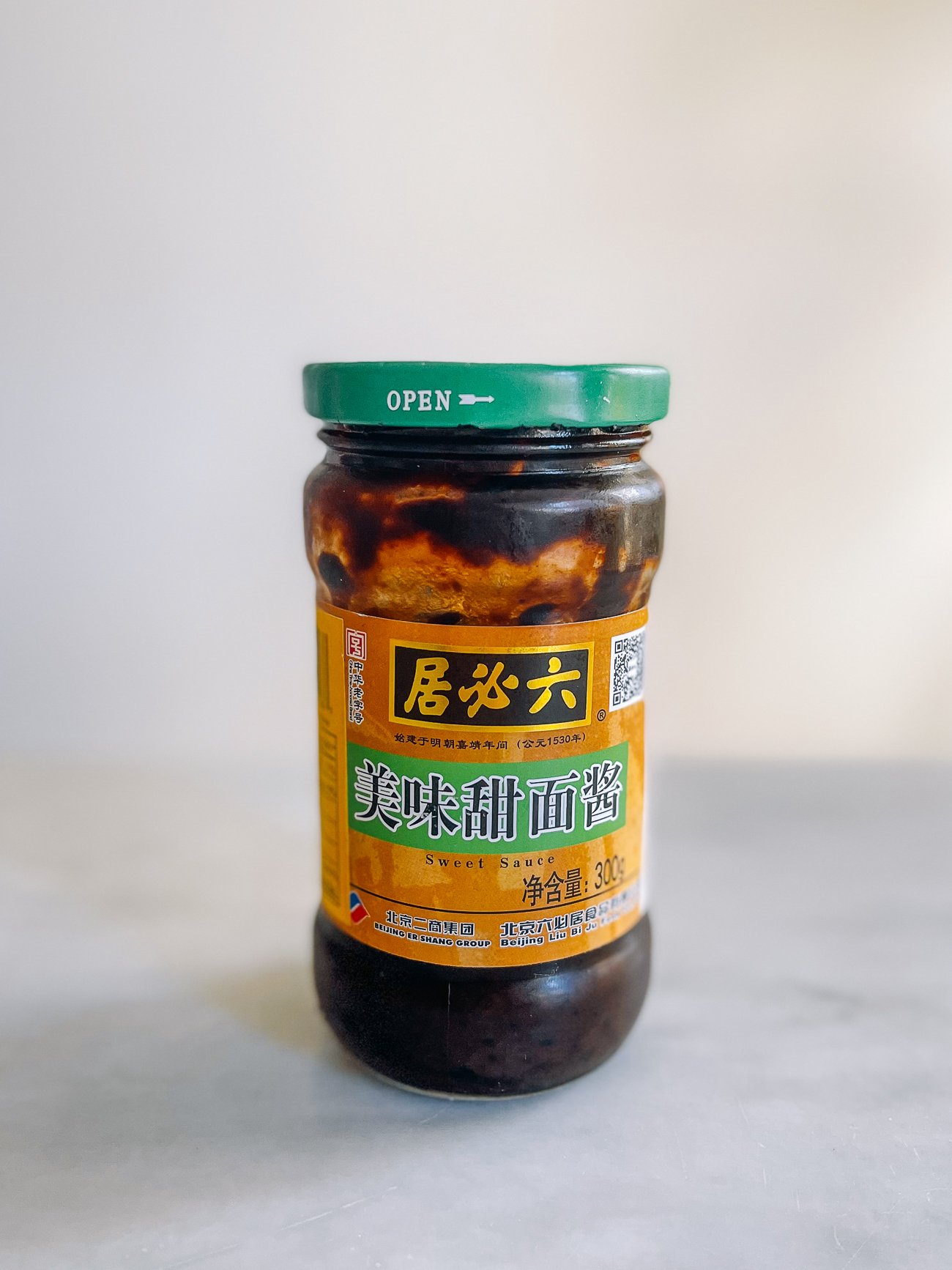
The “dry” soybean paste is literally dried to the point of needing to be reconstituted with water or a cooking wine (like Shaoxing wine).
It is also next to impossible to find in the U.S., so we have omitted it. But if you ever come across it, you can make a true traditional Zha Jiang Mian!
Even without the third paste, however, the flavor of the dish is excellent.
The Key is Skin-on Pork Belly
Skin-on pork belly is the traditional choice for Zha Jiang Mian, because it has ample amounts of pork fat that gets rendered in the wok to flavor the sauce. This also helps preserve the sauce for longer use (if you’ve ever heard of Spanish oil-cured cheese, it’s a similar concept).
In this recipe, the pork skin and fat is separated from the meatier bits in the first half of cooking to render the fat out. Then the leaner parts are added to the dish along with the seasonings to round everything out.
If you can’t find skin-on pork belly, you can use pork butt with some additional pork fat, or even ground pork with a higher fat percentage. You can also get away with using skinless pork belly, but that skin-on pork belly will yield the best results!
I bet using beef and some beef fat would be really tasty as well for anyone out there who doesn’t eat pork!
How to Store Zha Jiang Mian Sauce
This sauce should last about 10 days in the refrigerator in an airtight container, as long as you have a good layer of fat over the top of it.
Just always use a clean spoon to serve it. To keep it even longer, freeze it!
What Noodles to Use
You will want to use thicker noodles for this recipe, which offer a better balance to the saltiness of the sauce. The thicker noodles also hold up better to the chunky texture of the sauce.
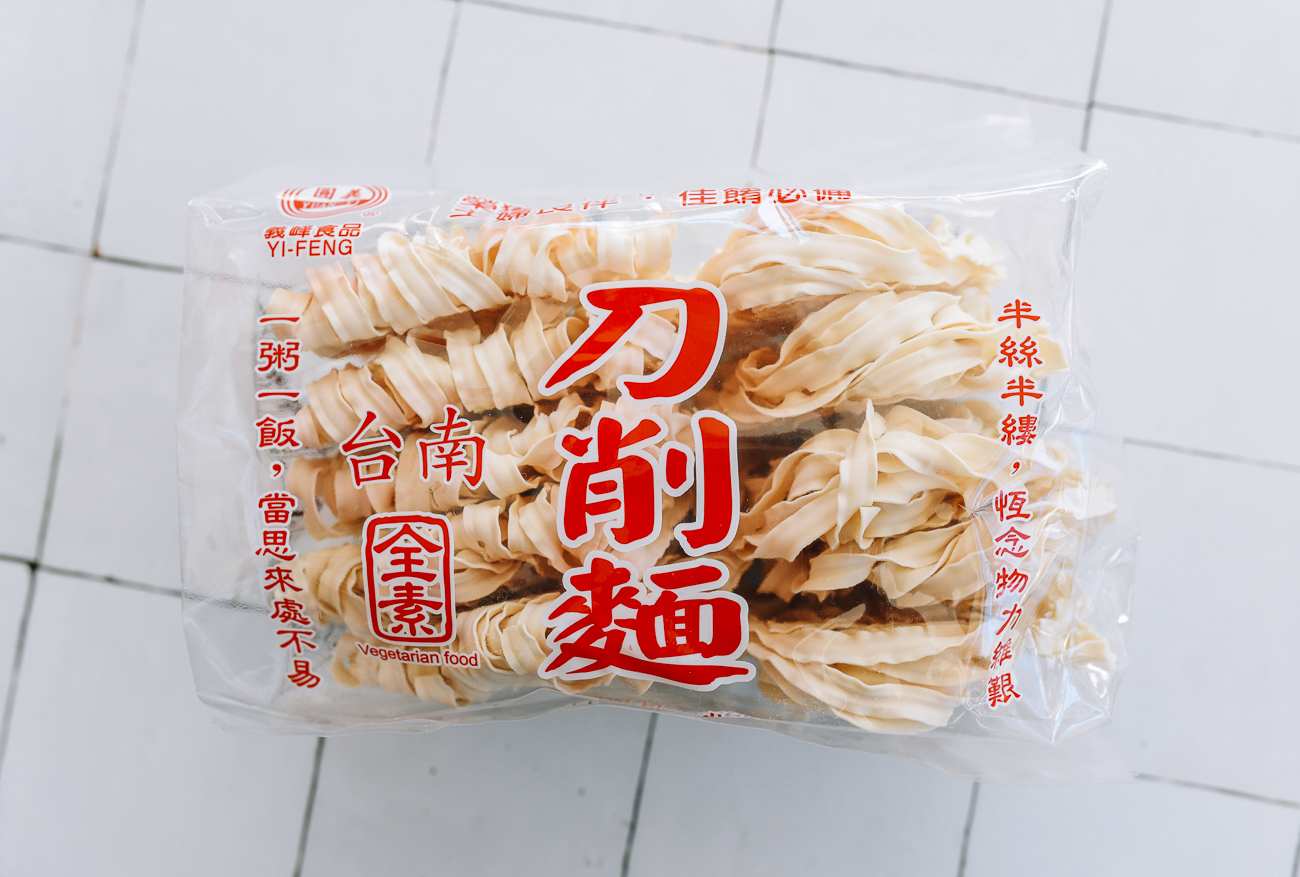
You can use thick white wheat noodles like the ribbon shape we’re using. Even something like a thick Shanghai-style noodle will do. We’ve also enjoyed this with thicker, flat egg noodles which was great as well.
A Quick Weeknight Meal
The most time-consuming part of this recipe is cutting the pork and rendering the fat. If you can prepare this step ahead of time, this dish actually comes together surprisingly quickly.
Once you’ve made the sauce, all you need to do is cut up some carrots and cucumbers, boil noodles, toss the noodles with the sauce, and you’re ready to eat!
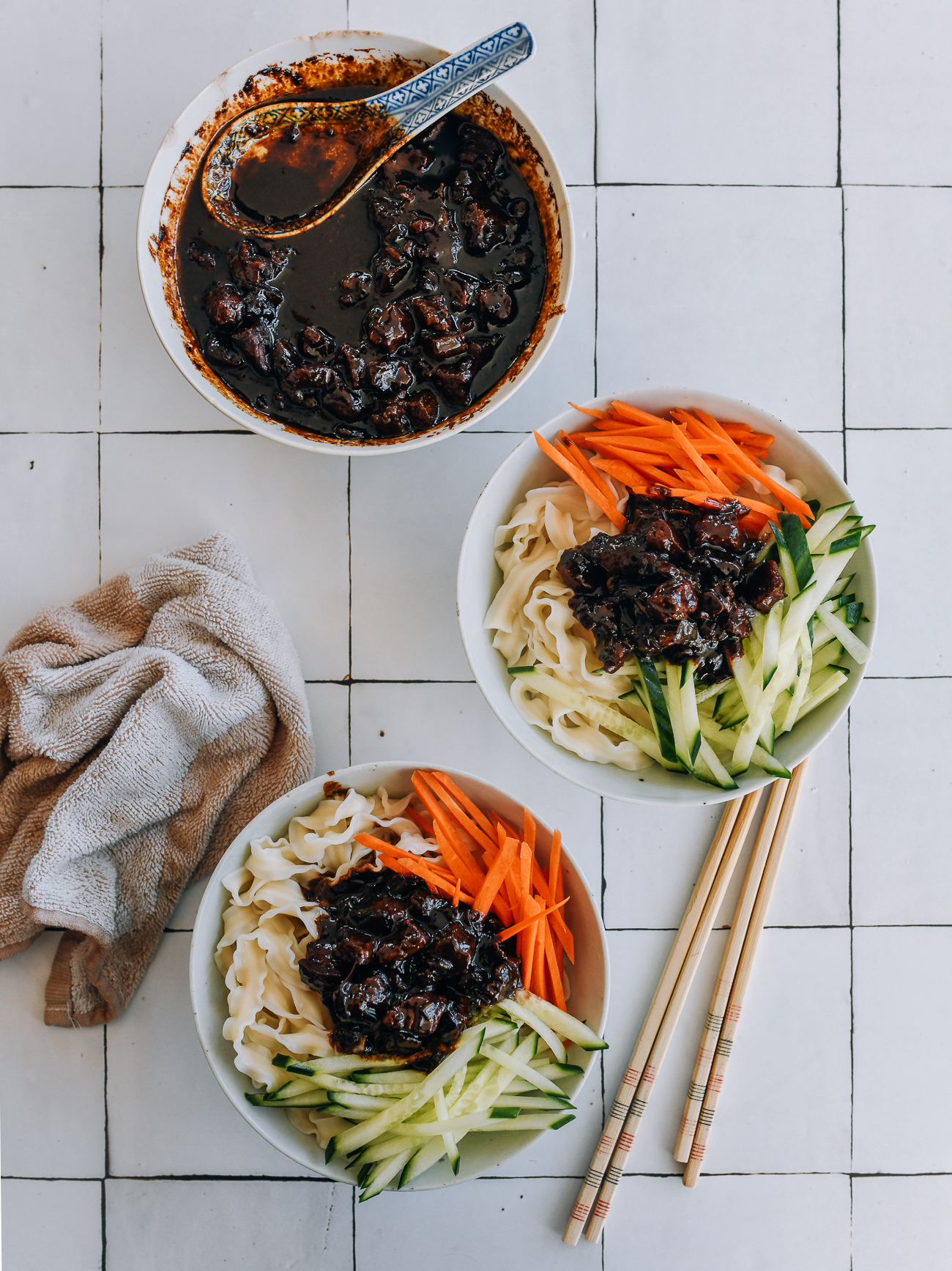
Zha Jiang Mian Recipe Instructions
Take your pork belly, and make a lengthwise cut to separate the thick layer of pork fat and skin from the leaner meat. Keeping them separate, cut both the fat (with the skin) and the meat into ½-inch pieces.
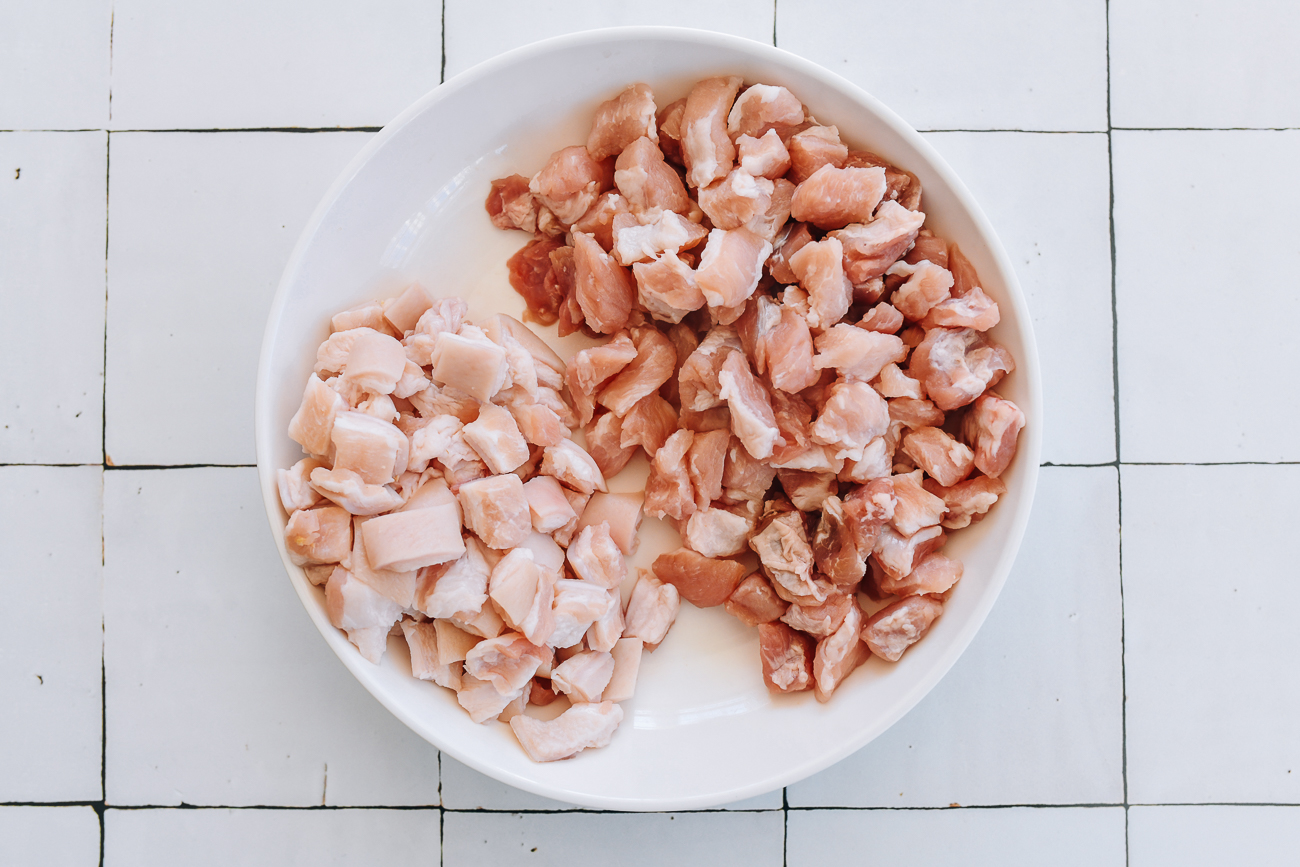
Mix the lean pork with 2 tablespoons of water (1 tablespoon at a time), until water is absorbed into the meat, and there is no visible standing liquid. Set aside.
In a wok over low heat, add the oil, along with the green parts of the scallion, ginger, star anise, bay leaves, cinnamon stick, and Sichuan peppercorns. Infuse the oil over low heat for about 15 minutes, or until the scallions turn crispy (not burned) and the oil smells fragrant. Take care not to burn the spices. Remove the aromatics using a slotted spoon, leaving the oil in the wok.
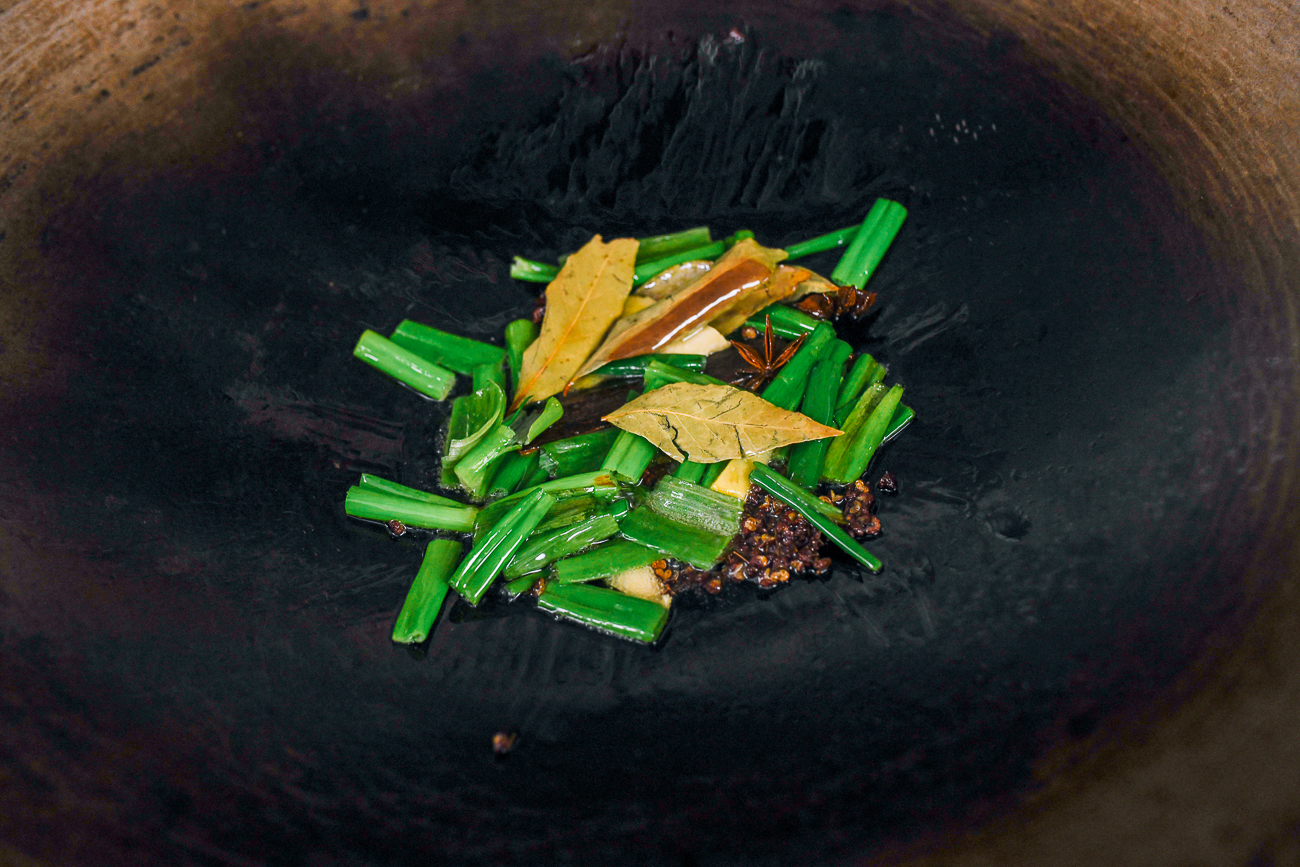
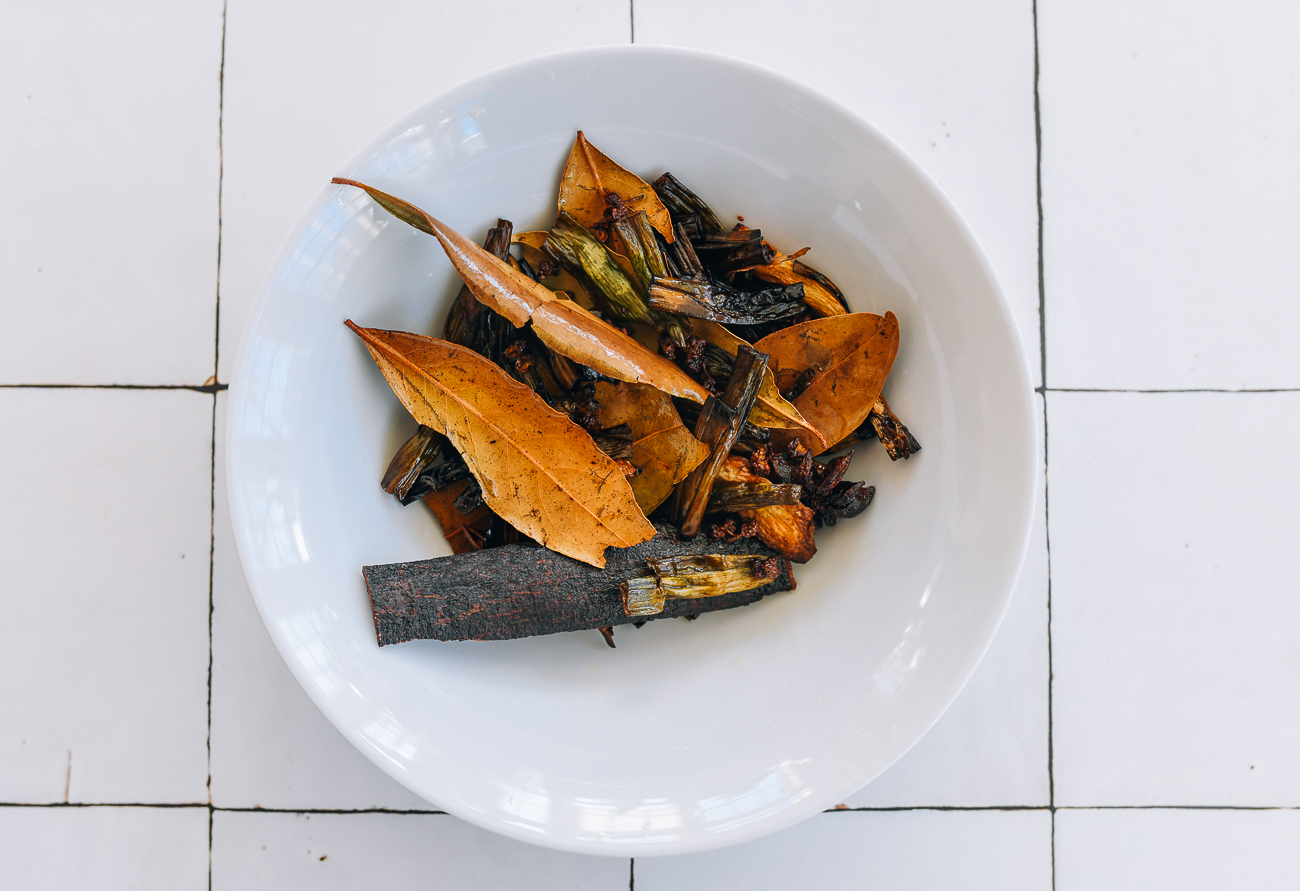
With the heat at medium-low, add the pork fat/skin. Render the fat for about 5-6 minutes, or until the pieces turn lightly golden around the edges.
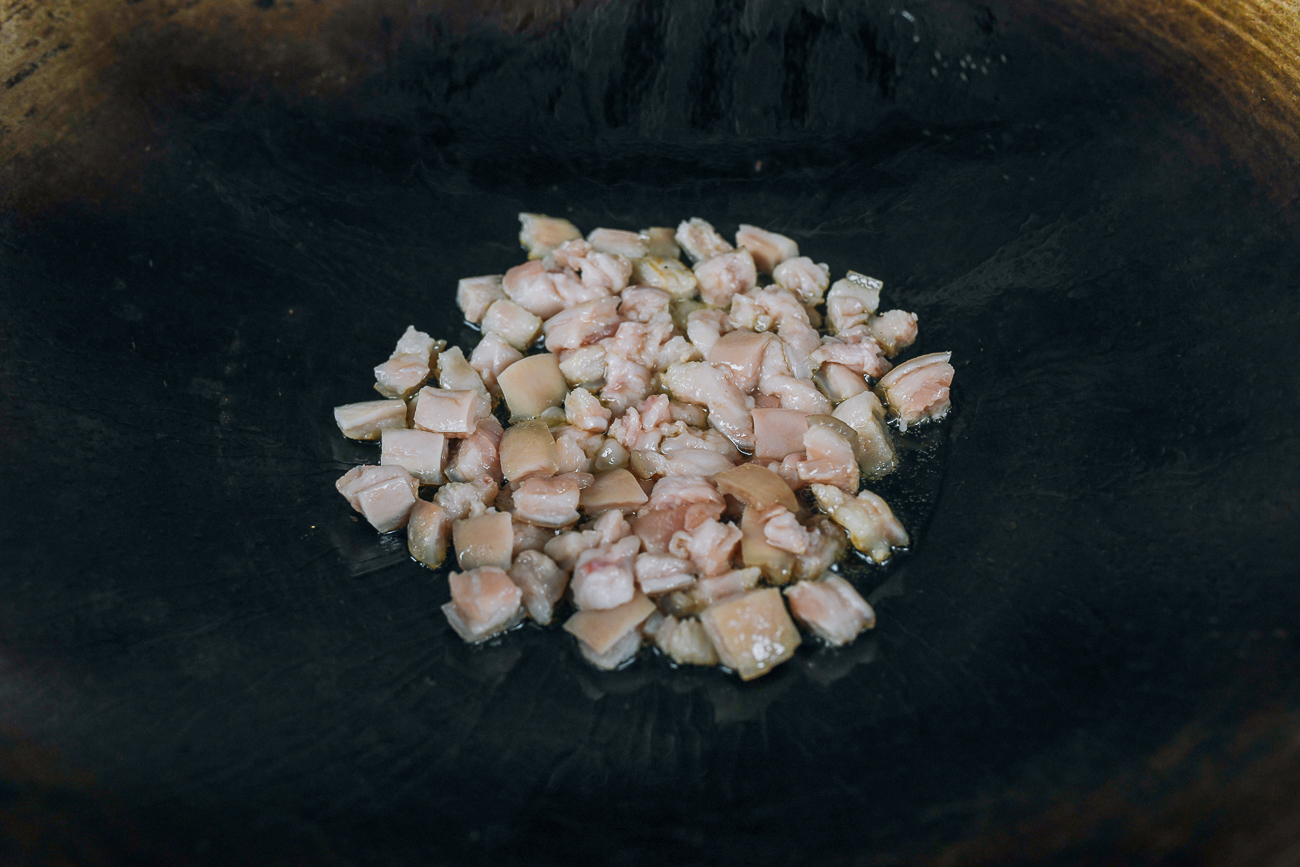
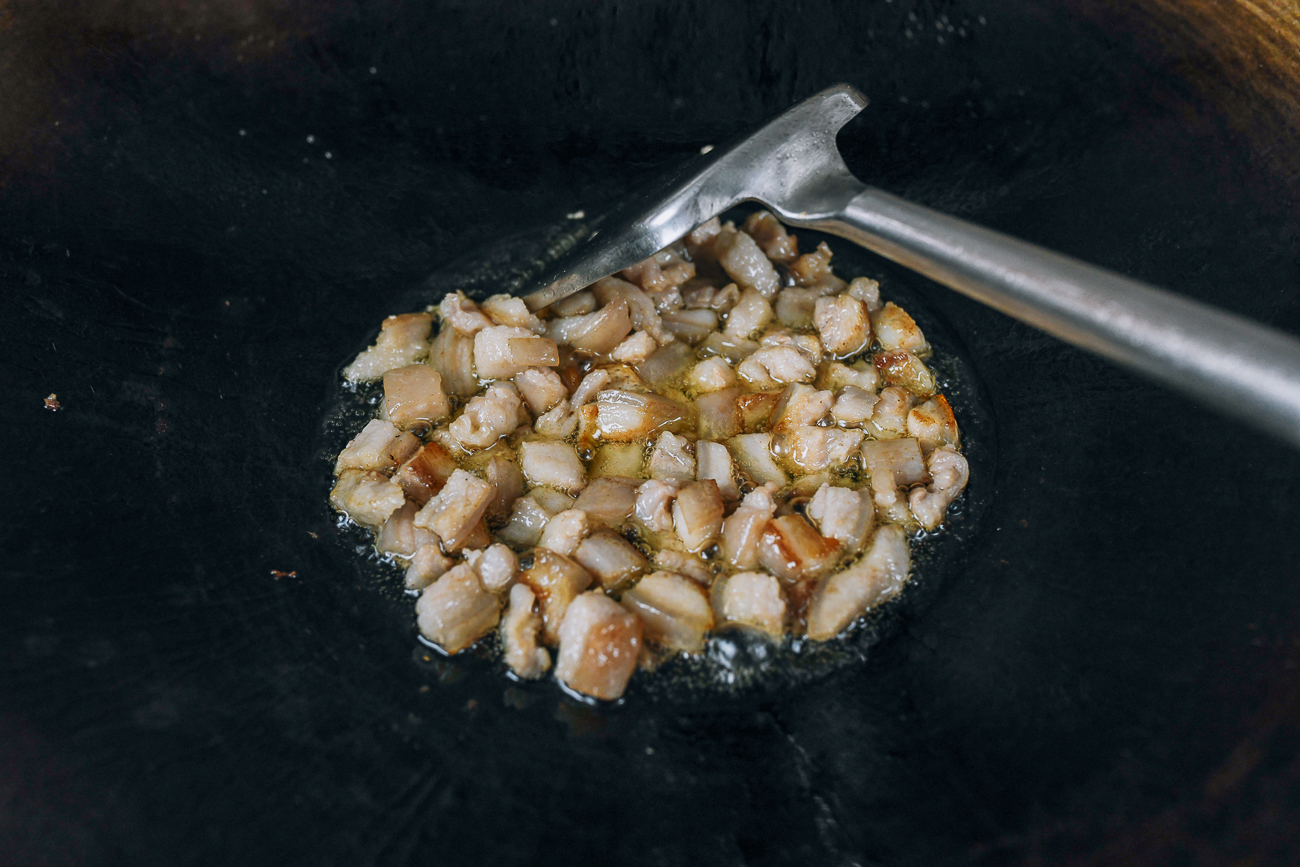
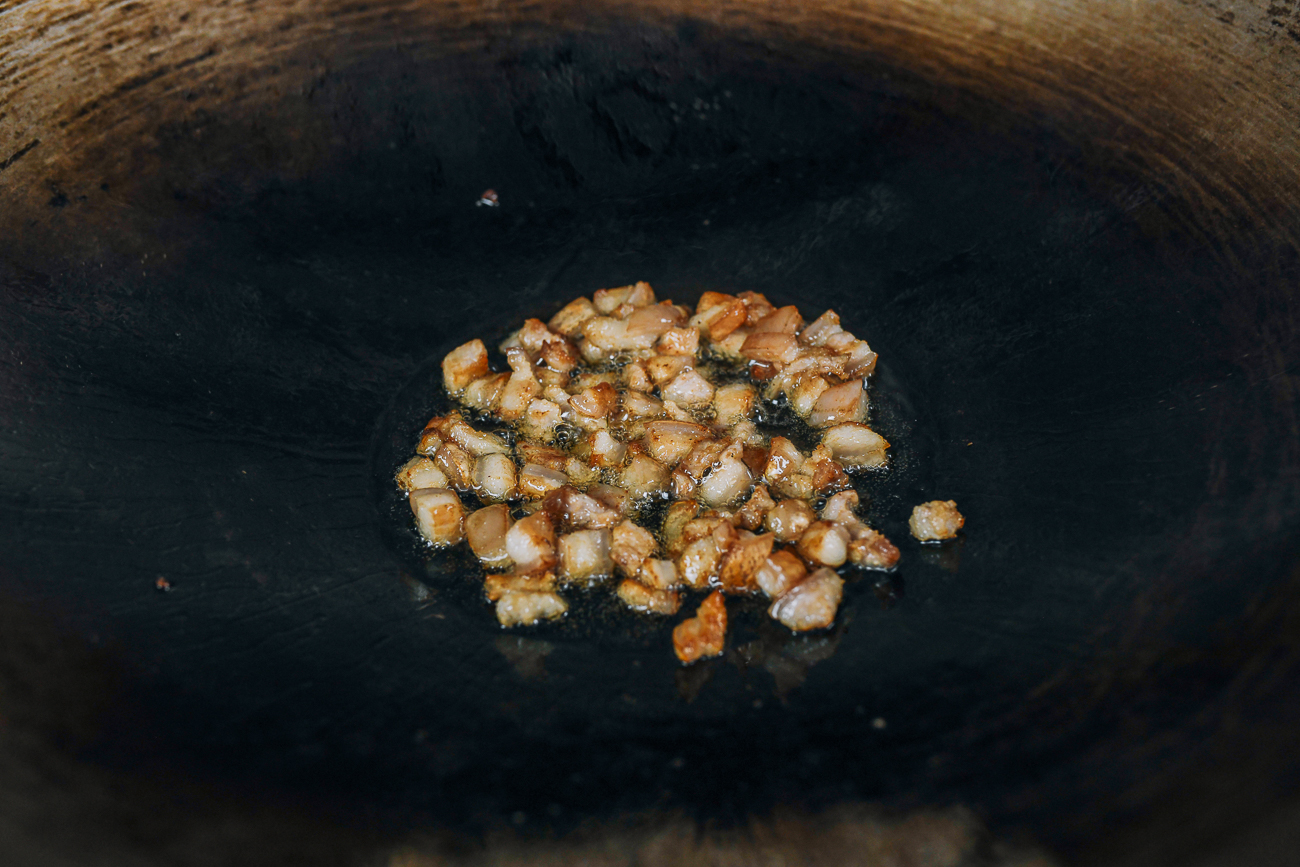
Add the lean pork. Cook for 1 minute, until the pork pieces turn white and opaque.
Reduce the heat to low, and add the Shaoxing wine, dark soy sauce, sweet bean sauce, ground bean sauce, water, and the white parts of the scallions. If using, add the sugar and salt. Stir everything together.
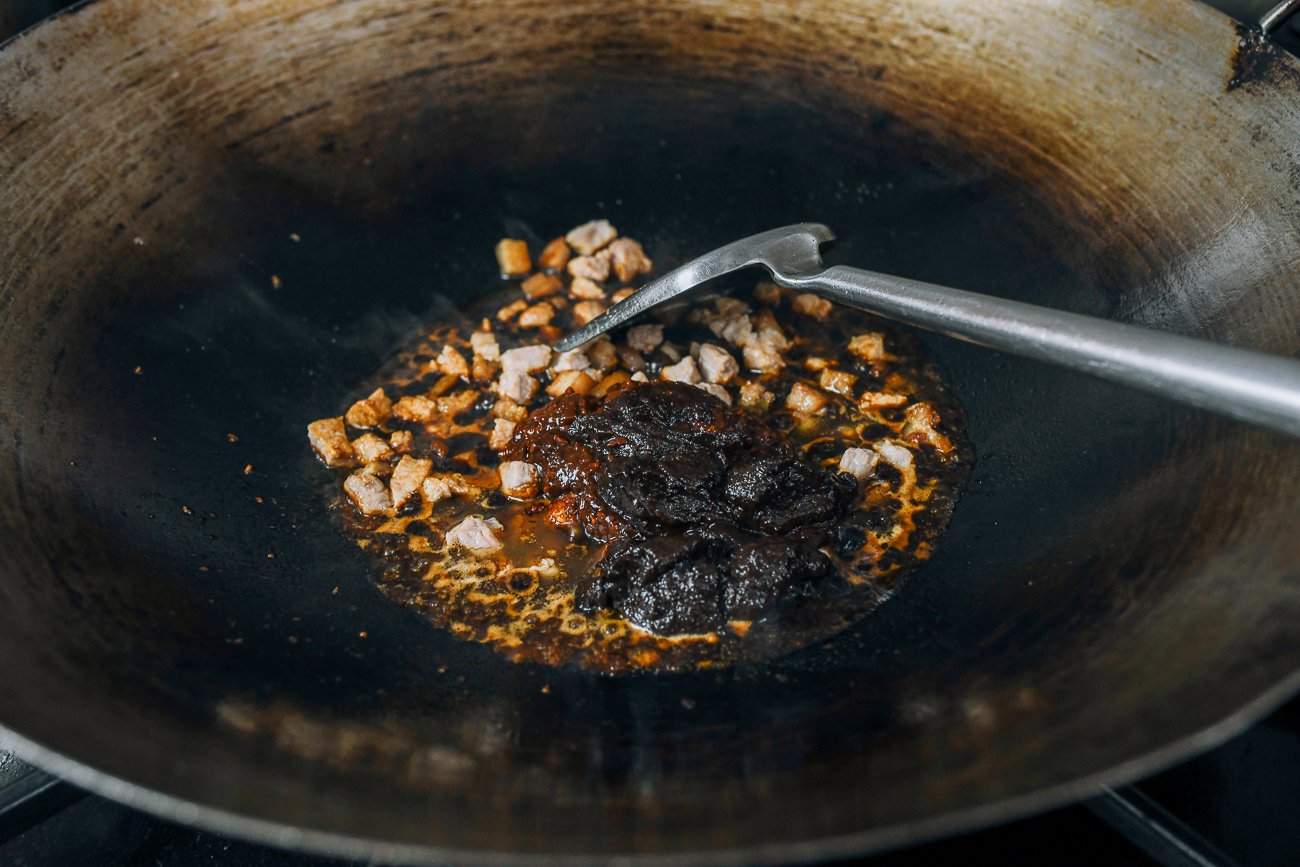
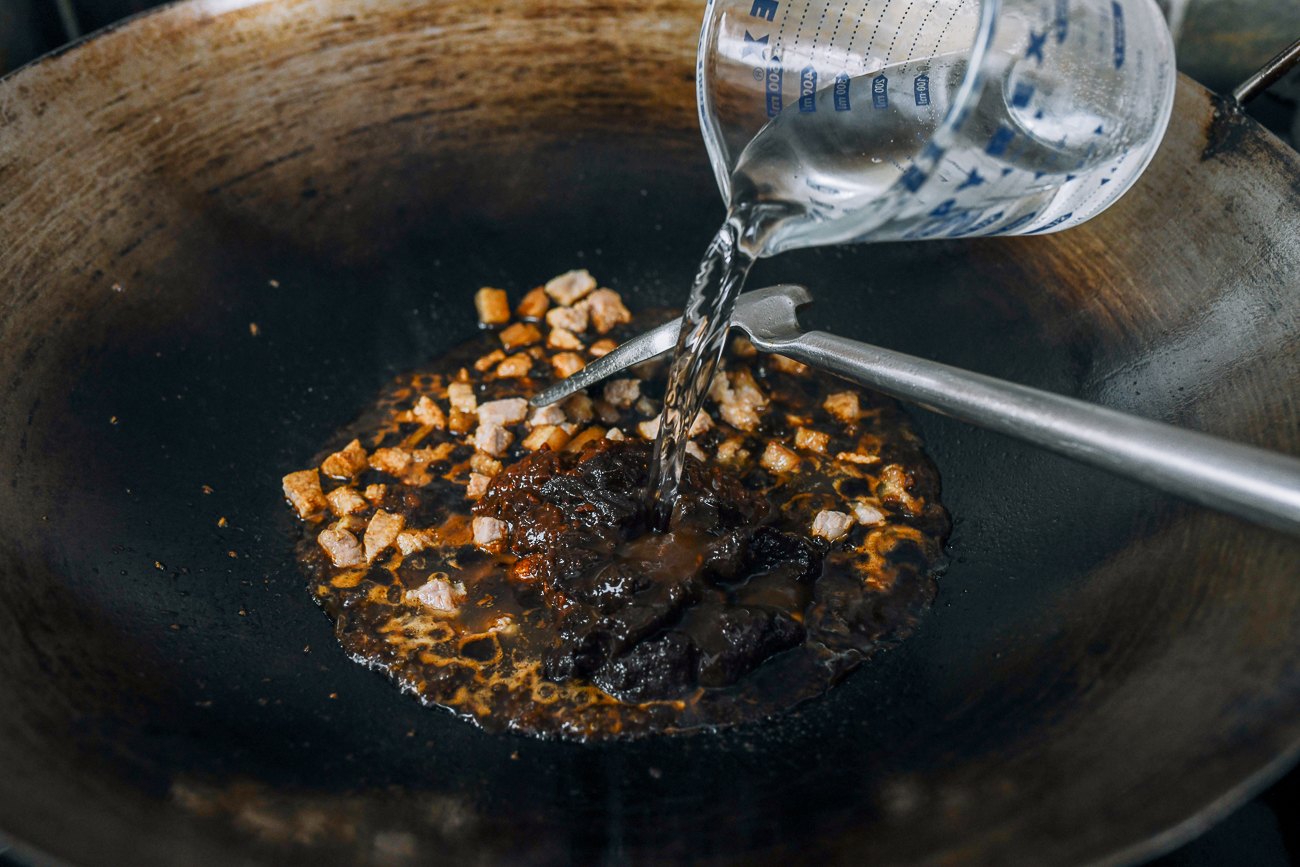
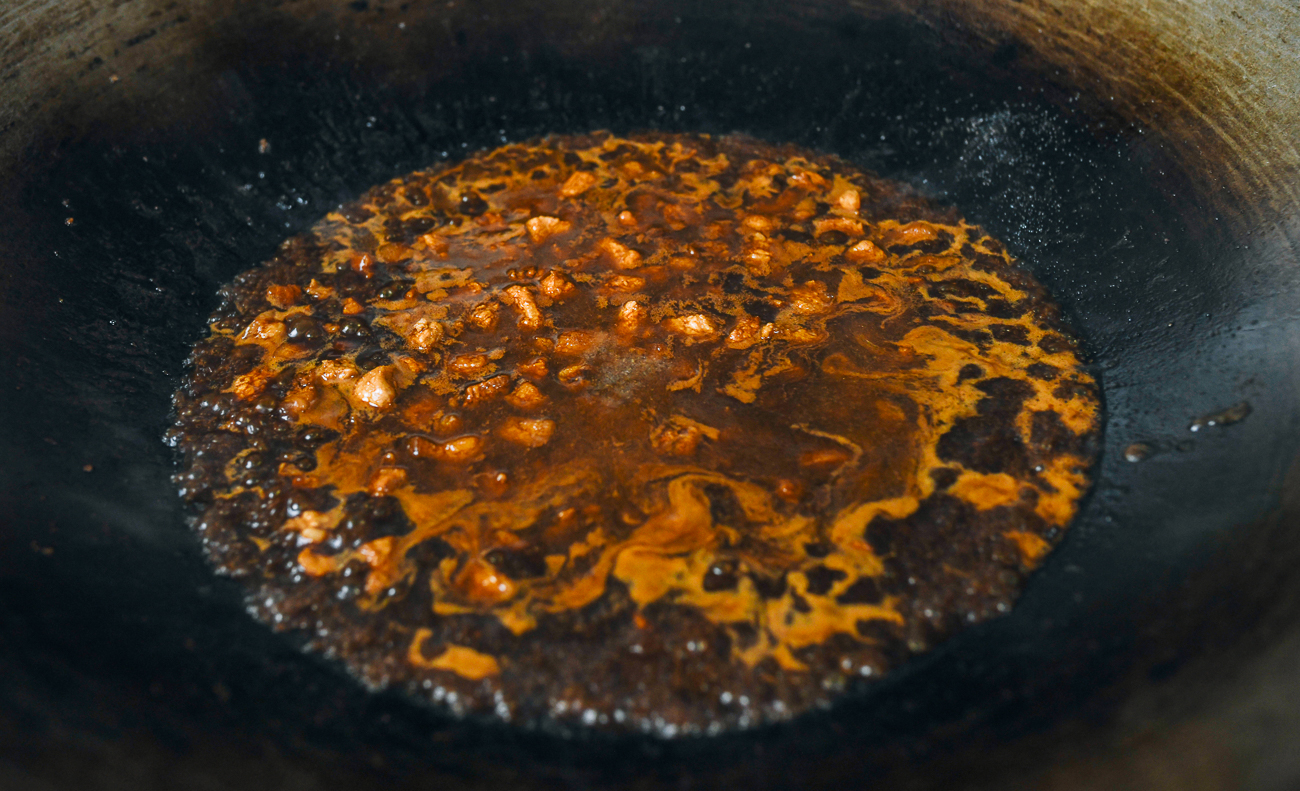
Cover and increase the heat to medium. Simmer for 10 minutes.
Uncover the wok, increase the heat to medium-high, and stir the sauce. As you push the sauce around with your wok spatula, it will start to bubble and thicken.
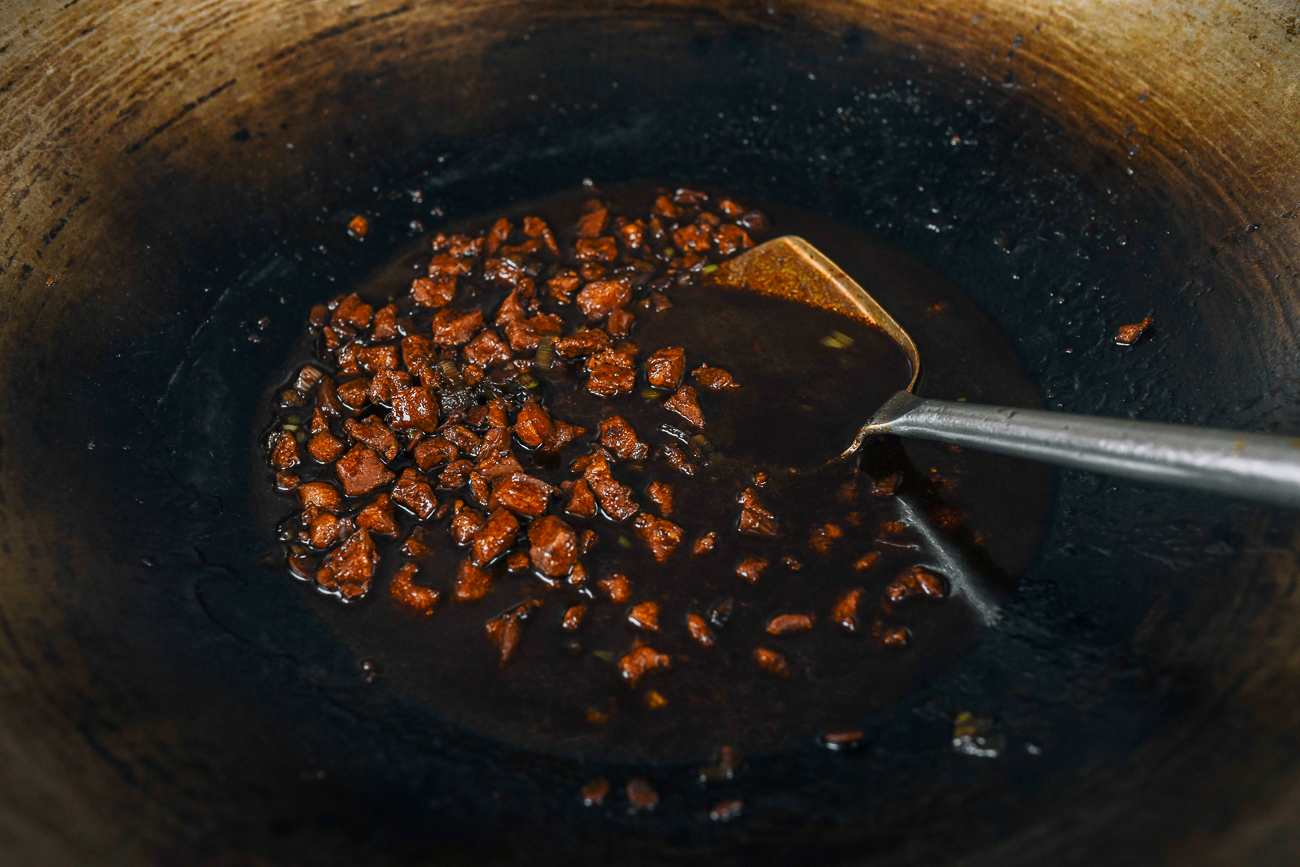
The oil and pork fat will start to coat the bottom of the wok.
Reduce the sauce for 8-12 minutes, until it’s viscous but not dry (so it coats the noodles easily!) Remove from the heat.
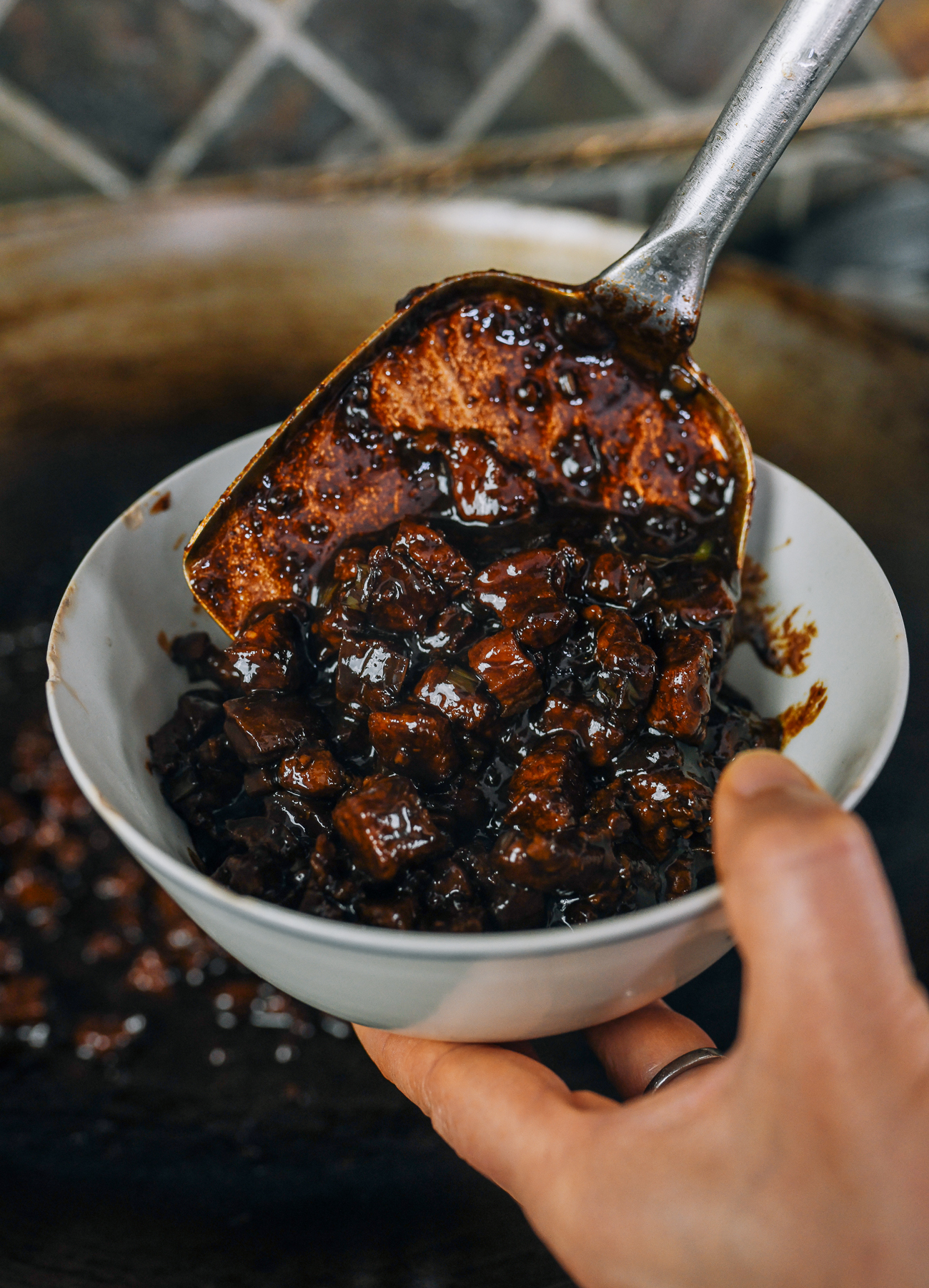
This sauce can be stored in the refrigerator for about 10 days, as long as you keep a layer of fat over the top. Just remember to use a clean utensil every time.
When you’re ready to enjoy the noodles, cook them in boiling water according to package instructions.
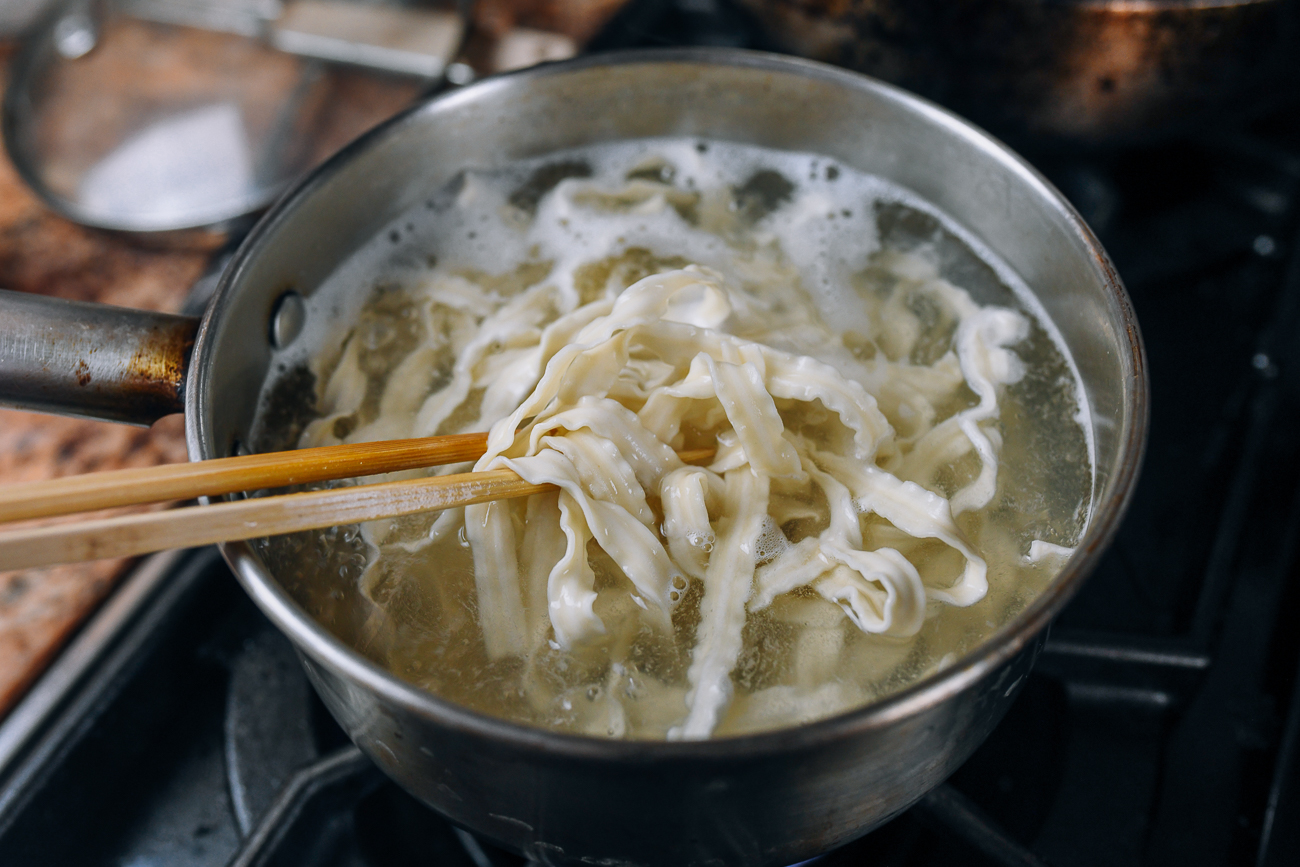
Noodle Cooking Tip!
If you’re cooking fresh noodles, make sure you use a large pot of water, as they’re starchier than dried noodles. To avoid them turning too starchy and sticky, add about ¼ cup of cold water every time the noodle water comes back up to a rolling boil.
While the water comes up to a boil and the noodles are cooking, prep the carrots, cucumber, and garlic (if using).
To serve, add some noodles to a bowl, mix with enough sauce to thinly and evenly coat the noodles—add it gradually until it’s the ideal level of saltiness for you. Top with the julienned carrots, cucumbers, and minced garlic.
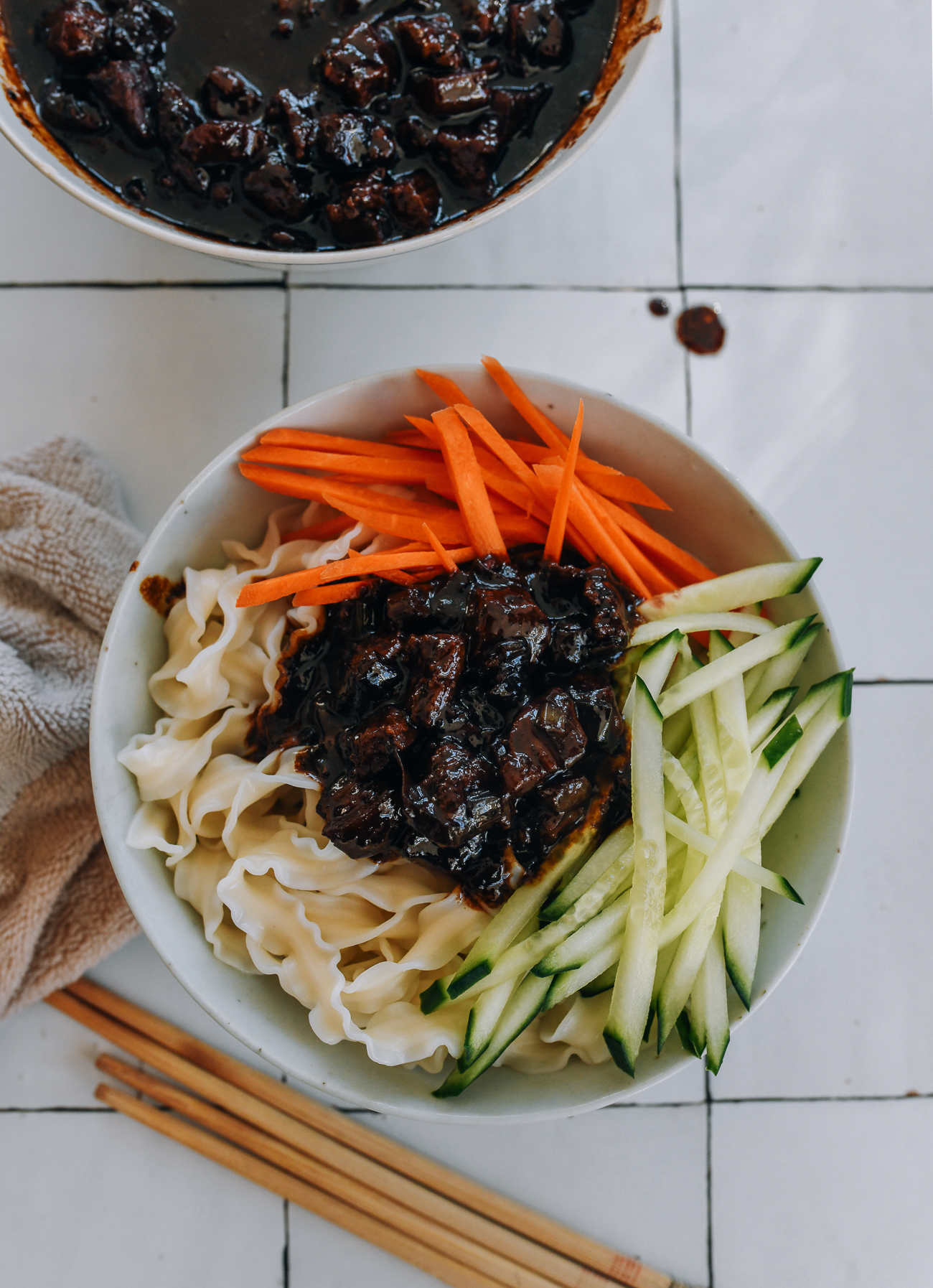
Mix and enjoy!
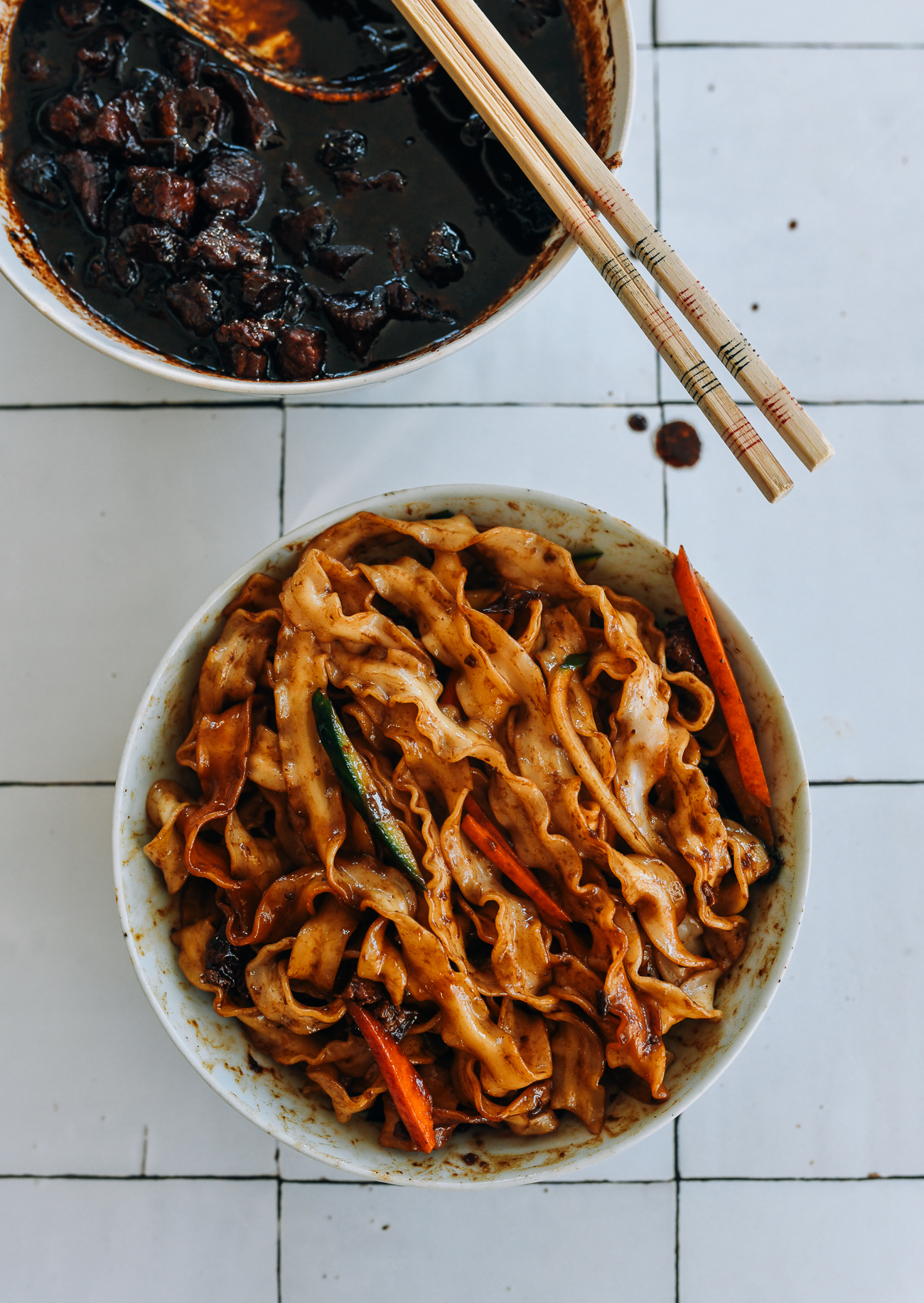
Let us know what you think when you try this Zha Jiang Mian Beijing classic!
Zha Jiang Mian (Beijing “Fried Sauce” Noodles)
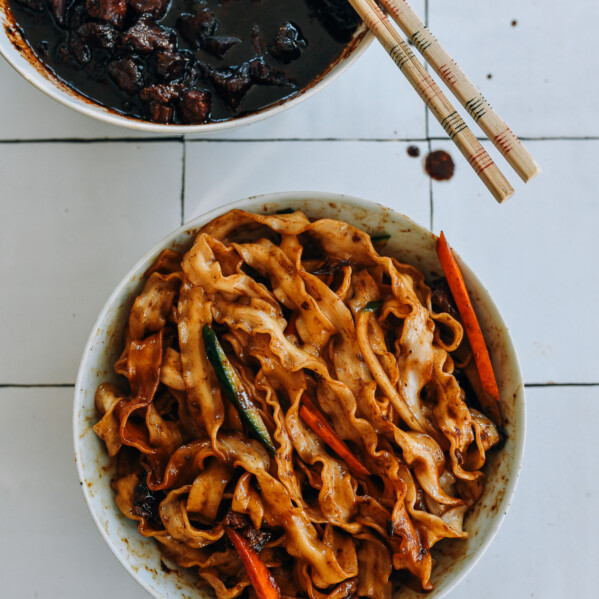
Ingredients
- 1 pound skin-on pork belly you can substitute fatty ground pork or a fatty cut of pork butt/shoulder
- 2 tablespoons water – 30 ml
- ⅓ cup neutral oil such as vegetable, canola, or avocado oil – 80ml
- 6 scallions finely chopped, white and green parts separated
- 5 slices ginger ⅛-inch/3mm thick
- 3 star anise pods
- 6 bay leaves
- 1 small cinnamon stick
- 2 teaspoons Sichuan peppercorns
- 4 tablespoons Shaoxing wine
- 1½ tablespoons dark soy sauce
- ¼ cup sweet bean sauce tianmianjiang – 甜面酱
- 3 heaping tablespoons ground bean sauce
- 1 cup water
- 1 teaspoon sugar optional
- ½ teaspoon salt optional, you can always add it later
To serve:
- 8 ounces dried wheat noodles (or 1 pound fresh wheat noodles)
- 1 cup julienned carrot
- 1 cup julienned cucumber
- 4 cloves garlic (minced, optional)
Instructions
- Take your pork belly, and make a lengthwise cut to separate the thick layer of pork fat and skin from the leaner meat. Keeping them separate, cut both the fat (with the skin) and the meat into ½-inch pieces.
- Mix the lean pork with 2 tablespoons of water (1 tablespoon at a time), until water is absorbed into the meat, and there is no visible standing liquid. Set aside.
- In a wok over low heat, add the oil, along with the green parts of the scallion, ginger, star anise, bay leaves, cinnamon stick, and Sichuan peppercorns. Infuse the oil over low heat for about 15 minutes, or until the scallions turn crispy (not burned) and the oil smells fragrant. Take care not to burn the spices. Remove the aromatics using a slotted spoon, leaving the oil in the wok.
- With the heat at medium-low, add the pork fat/skin. Render the fat for about 5-6 minutes, or until the pieces turn lightly golden around the edges. Add the lean pork. Cook for 1 minute, until the pork pieces turn white and opaque.
- Reduce the heat to low, and add the Shaoxing wine, dark soy sauce, sweet bean sauce, ground bean sauce, water, and the white parts of the scallions. If using, add the sugar and salt. Stir everything together.
- Cover and increase the heat to medium. Simmer for 10 minutes.
- Uncover the wok, increase the heat to medium-high, and stir the sauce. As you push the sauce around with your wok spatula, it will start to bubble and thicken. The oil and pork fat will start to coat the bottom of the wok. Reduce the sauce for 8-12 minutes, until it’s viscous but not dry (so it coats the noodles easily!) Remove from the heat.
- This sauce can be stored in the refrigerator for about 10 days, as long as you keep a layer of fat over the top. Just remember to use a clean utensil every time.
- When you’re ready to enjoy the noodles, cook them in boiling water according to package instructions. If you’re cooking fresh noodles, make sure you use a large pot of water, as they’re starchier than dried noodles. To avoid them turning too starchy and sticky, add about ¼ cup of cold water every time the noodle water comes back up to a rolling boil.
- While the water comes up to a boil and the noodles are cooking, prep the carrots, cucumber, and garlic (if using). To serve, add some noodles to a bowl, mix with enough sauce to thinly and evenly coat the noodles—add it gradually until it’s the ideal level of saltiness for you. Top with the julienned carrots, cucumbers, and minced garlic. Mix and enjoy!
Tips & Notes:
nutrition facts
Old version of the recipe:
For the original version of this recipe that we posted in 2014, I asked a local Beijing friend for their family recipe. He didn’t let us down, asking his sister (the best cook in their family) to write down her Zha Jiang Mian recipe for us. When I finally got the paper in my hands, I wasn’t quite sure what to say.
All the ingredients were there, of course. But no amounts were specified. It was much like asking for directions in Beijing. The usual reply you’ll get is something along the lines of, “It’s ahead!” No one seems to think you’d need any more information than that. How far ahead? What landmarks do I look for? Should I be walking or taking a cab?
I looked at the recipe and felt simultaneously confused…and flattered that she seemed to trust that I’d know what to do with her very cryptic and vague instructions.
With her seemingly incomplete zha jiang mian recipe, it ended up taking two tries to get it right. Here it is!
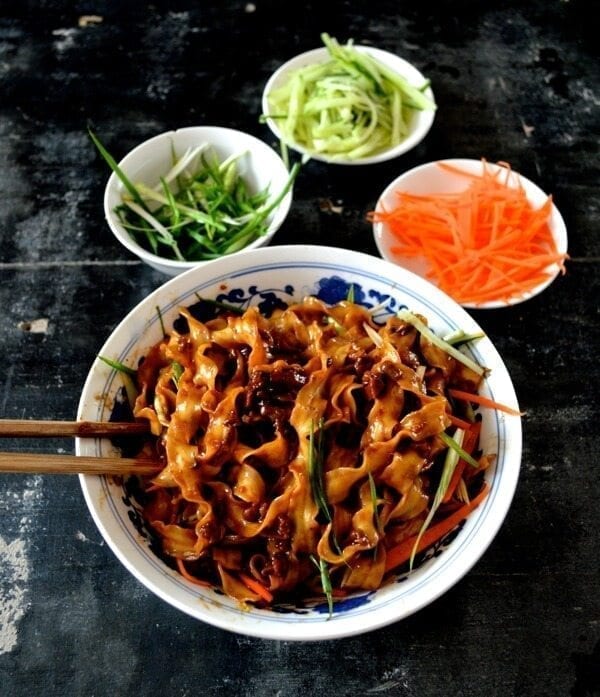
Ingredients
- 6 oz. ground pork(170g)
- ¼ teaspoon salt
- 1 teaspoon cornstarch
- ½ teaspoon oil (plus 1 tablespoon)
- 1/8 teaspoon white pepper
- 1 oz. pork fat (finely minced; optional)
- 3 slices ginger (minced finely)
- 4 cloves garlic (minced)
- 6 fresh shiitake mushrooms (finely chopped)
- 2 tablespoons sweet bean sauce (tianmianjiang – 甜面酱)
- 3 tablespoons ground bean sauce
- 1 tablespoon dark soy sauce
- 1 cup water
- 8 oz. dried wheat noodles (or 1 pound fresh wheat noodles)
- 1 cup carrots (julienned)
- 1 cup cucumbers (julienned)
- 1/2 cup scallions (julienned)
Instructions
Marinate the pork with the salt, cornstarch, ½ teaspoon oil, and white pepper.
Heat the remaining 1 tablespoon oil in your wok over medium heat and add the pork fat (if using).
Cook for 1 minute to render the fat down. Then add the marinated ground pork to the wok. Cook for 1 minute to brown it, and add the ginger and garlic. Let everything caramelize together.
Add the chopped shiitake mushrooms. Stir-fry everything together for another 2-3 minutes.
Add the sweet bean sauce, ground bean sauce, dark soy sauce, and water, stirring everything together well. Lower the heat and cover the wok. Simmer the sauce for 15-20 minutes, stirring occasionally to prevent sticking.
While that’s happening, cook the noodles according to the package directions. Mix with the sauce and toss with the julienned carrots, cucumbers, and scallions. (The amount of sauce made in this Zha Jiang Mian recipe should be good for 4 servings.) Serve!
